Tambor/Gar Class: Difference between revisions
Pbcjohnston (talk | contribs) →Grayling (SS-209)*: Added photo and caption |
Pbcjohnston (talk | contribs) →Gudgeon (SS-211)*: Swapped pictures from other page |
||
| (14 intermediate revisions by the same user not shown) | |||
| Line 1: | Line 1: | ||
[[File:Header | {{#seo:|title=Submarines of the Tambor and Gar class - PigBoats.COM}} | ||
{{#seo:|description=Notes, photographs, and pictures of the U.S. Navy's Tambor/Gar-class submarines.}} | |||
[[File:New Header Tambor Gar-class.jpg]] | |||
=== <big>Design and Construction Notes</big> === | === <big>Design and Construction Notes</big> === | ||
<div style="text-align: justify;"><span style="color:#00008B">The twelve submarines of the Tambor and Gar classes were the high water mark of pre-war submarine construction in the USN. Although authorized in two different fiscal years (FY-39 & 40), the six boats each of the Tambor and Gar classes were actually identical in design with no significant differences between the two groups. They will be treated as one class here on PigBoats. The design of these boats rolled into one all of the lessons that had been learned during the 20 years of peacetime trial and error development, and their origin dates back to the beginning of the V-class in 1921. | <div style="text-align: justify;"><span style="color:#00008B">The twelve submarines of the Tambor and Gar classes were the high water mark of pre-war submarine construction in the USN. Although authorized in two different fiscal years (FY-39 & 40), the six boats each of the Tambor and Gar classes were actually identical in design with no significant differences between the two groups. They will be treated as one class here on PigBoats. The design of these boats rolled into one all of the lessons that had been learned during the 20 years of peacetime trial and error development, and their origin dates back to the beginning of the V-class in 1921. They were well liked and rugged in design and quite advanced for the time. There were however, three criticisms of these boats. Firstly, their design had been optimized for peacetime cruising and thus needed modifications to be optimal to fight the war they faced. Second, they were officially rated with only a 250-foot test depth, an overly conservative value that initially limited underwater evasion tactics. Third, all four engines were contained in one large room, and there were fears of catastrophic flooding should the engine room be breached. In the end these issues were relatively minor in nature, and would be corrected in the follow-on Gato-class. All of these boats turned in superb service during the war. | ||
Maintaining the construction trend that had started with the Porpoise class, the Tambor/Gars were divided up for construction between the Portsmouth Navy Yard (four boats), Electric Boat (six boats), and the Mare Island Navy Yard (two boats). Based on repeated calls by the Submarine Officers Conference for a heavier armament, these boats were equipped with six bow and four stern 21" torpedo tubes, carrying a total of 24 torpedoes. For gun armament, they were built with a 3"/50 caliber Mk 17 gun and one or two M2 .50 caliber water cooled machine guns. Starting in the summer of 1942, six of these boats (Tambor, Thresher, Tuna, Gar, Grayback, and Grayling) were refitted to carry a much larger and more powerful 5"/51 caliber Mk 9 gun, located on an expanded sponson on the aft deck. Three of the guns had been originally installed on the earlier Barracuda-class fleet boats, the other three were production spares. Gun armament varied considerably during the war, with the boats that did not get the big gun getting a 4"/50 caliber Mk 9 gun, taken mostly from older S-boats. | Maintaining the construction trend that had started with the Porpoise class, the Tambor/Gars were divided up for construction between the Portsmouth Navy Yard (four boats), Electric Boat (six boats), and the Mare Island Navy Yard (two boats). Based on repeated calls by the Submarine Officers Conference for a heavier armament, these boats were equipped with six bow and four stern 21" torpedo tubes, carrying a total of 24 torpedoes. For gun armament, they were built with a 3"/50 caliber Mk 17 gun and one or two Browning M2 .50 caliber water-cooled machine guns. Starting in the summer of 1942, six of these boats (Tambor, Thresher, Tuna, Gar, Grayback, and Grayling) were refitted to carry a much larger and more powerful 5"/51 caliber Mk 9 gun, located on an expanded sponson on the aft deck. Three of the guns had been originally installed on the earlier Barracuda-class fleet boats, the other three were production spares. Gun armament varied considerably during the war, with the boats that did not get the big gun getting a 4"/50 caliber Mk 9 gun, taken mostly from older S-boats. | ||
These boats were in the thick of the fight against the Japanese from the first day of the war. Seven of them (marked by a *) and their brave crews were lost in action and are considered to be "on eternal patrol". | These boats were in the thick of the fight against the Japanese from the first day of the war. Seven of them (marked by a *) and their brave crews were lost in action and are considered to be "on eternal patrol". | ||
As with all of the pre-war built fleet submarines, once the war started their external appearance was heavily modified as experience was gained. These changes came fast and often, and it is easy to be confused by it all. The authors highly recommend that you read the Visual Guide article posted [ | As with all of the pre-war built fleet submarines, once the war started their external appearance was heavily modified as experience was gained. These changes came fast and often, and it is easy to be confused by it all. The authors highly recommend that you read the Visual Guide article posted [https://pigboats.com/images/3/3b/A_VISUAL_GUIDE_TO_THE_FLEET_SUBMARINES_PART_4_GATO_CLASS_2024.pdf '''at this link''']. | ||
</span></div> | |||
''' | |||
[[File:Red bar sub new 2.jpg]] | [[File:Red bar sub new 2.jpg]] | ||
| Line 25: | Line 27: | ||
[[File:Tautog stbd quarter 1940.jpg|left|500px|U.S. Navy photo.]] | [[File:Tautog stbd quarter 1940.jpg|left|500px|U.S. Navy photo.]] | ||
<div style="text-align: justify;"><span style="color:#00008B">Tautog underway in Cape Cod Bay after running the measured mile off Provincetown, MA., July 1940. This photo highlights one of the prime differences between the Tambor/Gar-class boats and earlier | <div style="text-align: justify;"><span style="color:#00008B">Tautog underway in Cape Cod Bay after running the measured mile off Provincetown, MA., July 1940. This photo highlights one of the prime differences between the Tambor/Gar-class boats and earlier classes. The superstructure now ends short of the stern. On the aft deck is the 3"/50 caliber Mk 17 gun. The mount is quite tall and is visually distinctive. The intention here was to provide the ability to greatly elevate the gun for use with fused anti-aircraft rounds. In practice the boats were rarely supplied with such rounds, as it was felt that taking on aircraft was far too dangerous.</span> | ||
[[199|See more Tautog photos]] | [[199|See more Tautog photos]] | ||
| Line 34: | Line 36: | ||
[[File:Thresher near bridge.jpg|left|500px|U.S. Navy photo. An original print in the private collection of Ric Hedman.]] | [[File:Thresher near bridge.jpg|left|500px|U.S. Navy photo. An original print in the private collection of Ric Hedman.]] | ||
<div style="text-align: justify;"><span style="color:#00008B">Thresher passing under the U.S. Route 1 Bridge spanning the Thames River between New London and Groton, CT. The date is 1940. Judging by the wake she is running at approximately | <div style="text-align: justify;"><span style="color:#00008B">Thresher passing under the U.S. Route 1 Bridge spanning the Thames River between New London and Groton, CT. The date is 1940. Judging by the wake she is running at approximately six knots, but unusually she is running on the battery. No diesel exhaust or overboards are seen. It looks like she is headed upriver towards Submarine Base New London. This would explain the large number of men topside. They are anticipating their return home.</span> | ||
[[200|See more Thresher photos]] | [[200|See more Thresher photos]] | ||
| Line 88: | Line 90: | ||
[[File:Grayback 1943.jpg|left|500px|USN photo 6139-43, courtesy of Darryl L. Baker via Navsource.org]] | [[File:Grayback 1943.jpg|left|500px|USN photo 6139-43, courtesy of Darryl L. Baker via Navsource.org]] | ||
<div style="text-align: justify;"><span style="color:#00008B">Grayback viewed here broad on the starboard side in San Francisco Bay after her last wartime overhaul, August 26, 1943. Her conning tower fairwater | <div style="text-align: justify;"><span style="color:#00008B">Grayback viewed here broad on the starboard side in San Francisco Bay after her last wartime overhaul, August 26, 1943. Her conning tower fairwater sports a Mod 3 Long Bridge configuration, with the forward and aft portions cut away with 20mm guns added on those gun decks, SJ radar added to the front of the periscope shears and SD added aft of the shears. Grayback is one of the six Tambor/Gar-class boats that received the large and powerful 5"/51 caliber Mk 9 gun. The gun was large enough that an expanded sponson had to be built around the aft gun mount to give the gun crew enough deck space to train the gun.</span> | ||
[[208|See more Grayback photos]] | [[208|See more Grayback photos]] | ||
| Line 104: | Line 106: | ||
=== <big>Grenadier (SS-210)*</big> === | === <big>Grenadier (SS-210)*</big> === | ||
[[File]] | |||
<div style="text-align: justify;"><span style="color:#00008B"> | [[File:Grenadier launch.jpg|left|500px|Photo 08 06 023289 courtesy of the Boston Public Library, Leslie Jones Collection]] | ||
<div style="text-align: justify;"><span style="color:#00008B">Grenadier shortly after launch from the Portsmouth Navy Yard, Kittery, ME. on a cold but calm November 29, 1940. Much work remains to be done, including the installation of her periscope shears and masts. This photo gives a good view of the Government design for the towing fairlead bullnose, which is the old style above deck steel ring.</span> | |||
[[210|See more Grenadier photos]] | [[210|See more Grenadier photos]] | ||
| Line 112: | Line 115: | ||
=== <big>Gudgeon (SS-211)*</big> === | === <big>Gudgeon (SS-211)*</big> === | ||
[[File]] | |||
<div style="text-align: justify;"><span style="color:#00008B"> | [[File:Gudgeon summer 1941.jpg|left|500px|USN photo # 1422-41, courtesy of Darryl L. Baker and Navsource.org]] | ||
<div style="text-align: justify;"><span style="color:#00008B">A port quarter shot of a lazy but soon to be quite busy Gudgeon in the Pacific off San Francisco, July 7, 1941. The port side forward engine in the engine room is lit off and running. She would soon head off on an inspection tour of Alaskan and Aleutian Islands harbors to determine their suitability as bases. Proceeding to Hawaii in the fall, she would be at anchor of Lahaina, Maui on the morning of December 7, 1941. | |||
[[211|See more Gudgeon photos]] | [[211|See more Gudgeon photos]] | ||
Latest revision as of 19:42, 8 May 2025
Design and Construction Notes
Maintaining the construction trend that had started with the Porpoise class, the Tambor/Gars were divided up for construction between the Portsmouth Navy Yard (four boats), Electric Boat (six boats), and the Mare Island Navy Yard (two boats). Based on repeated calls by the Submarine Officers Conference for a heavier armament, these boats were equipped with six bow and four stern 21" torpedo tubes, carrying a total of 24 torpedoes. For gun armament, they were built with a 3"/50 caliber Mk 17 gun and one or two Browning M2 .50 caliber water-cooled machine guns. Starting in the summer of 1942, six of these boats (Tambor, Thresher, Tuna, Gar, Grayback, and Grayling) were refitted to carry a much larger and more powerful 5"/51 caliber Mk 9 gun, located on an expanded sponson on the aft deck. Three of the guns had been originally installed on the earlier Barracuda-class fleet boats, the other three were production spares. Gun armament varied considerably during the war, with the boats that did not get the big gun getting a 4"/50 caliber Mk 9 gun, taken mostly from older S-boats.
These boats were in the thick of the fight against the Japanese from the first day of the war. Seven of them (marked by a *) and their brave crews were lost in action and are considered to be "on eternal patrol".
As with all of the pre-war built fleet submarines, once the war started their external appearance was heavily modified as experience was gained. These changes came fast and often, and it is easy to be confused by it all. The authors highly recommend that you read the Visual Guide article posted at this link.
Tambor (SS-198)

Tautog (SS-199)
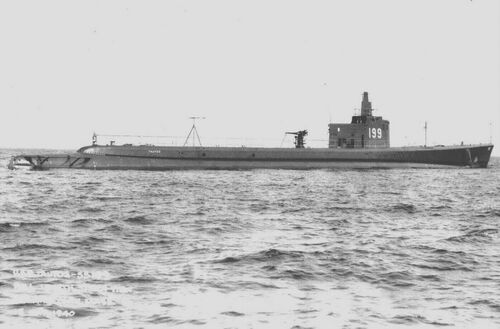
Thresher (SS-200)
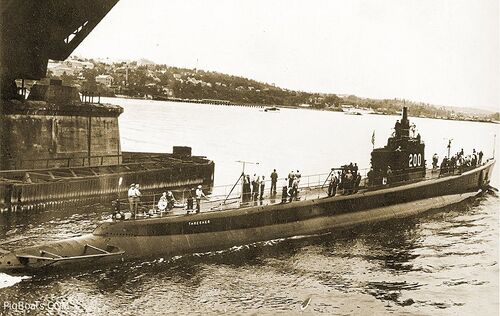
Triton (SS-201)*
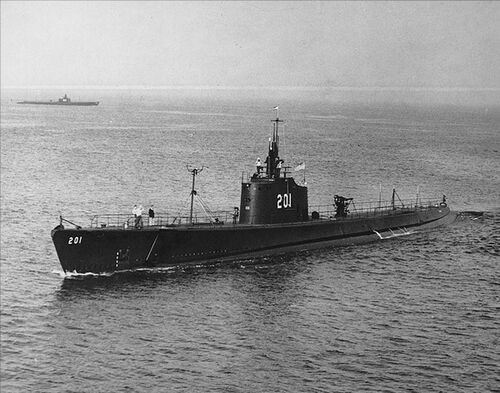
Trout (SS-202)*
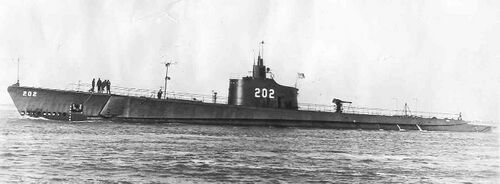
Tuna (SS-203)

Gar (SS-206)
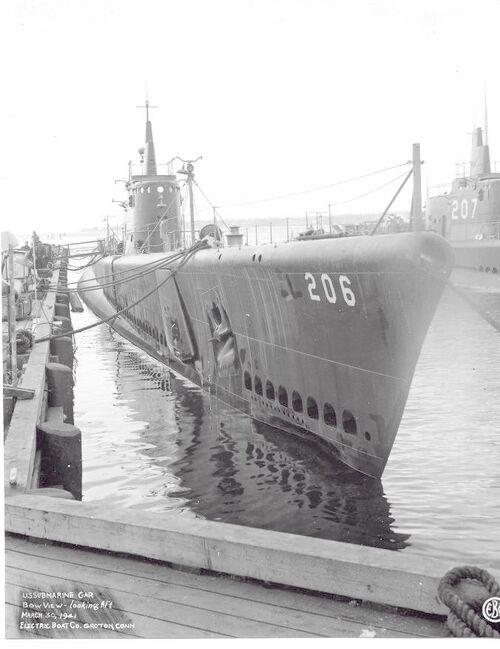
Grampus (SS-207)*

Grayback (SS-208)*
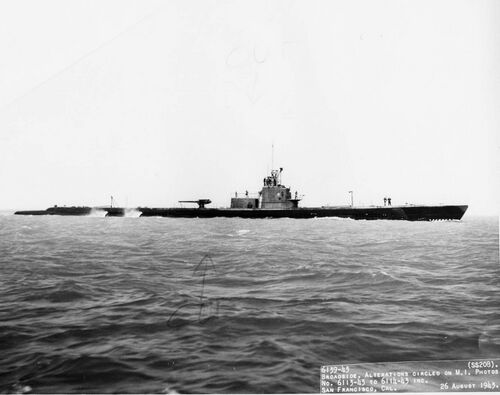
Grayling (SS-209)*
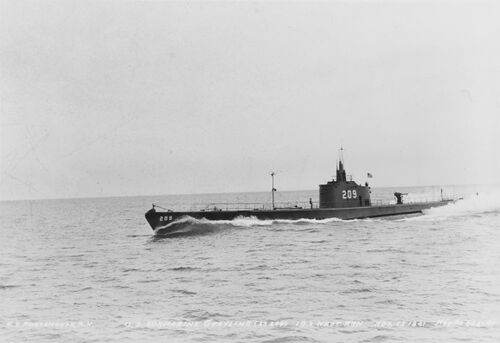
Grenadier (SS-210)*
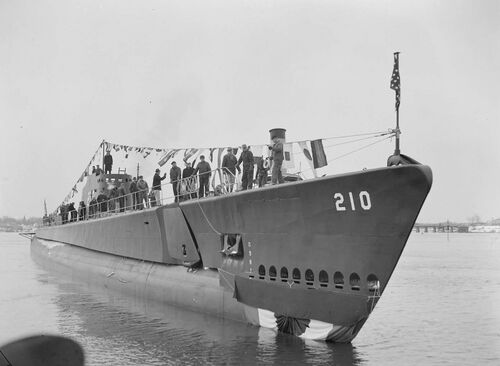
Gudgeon (SS-211)*
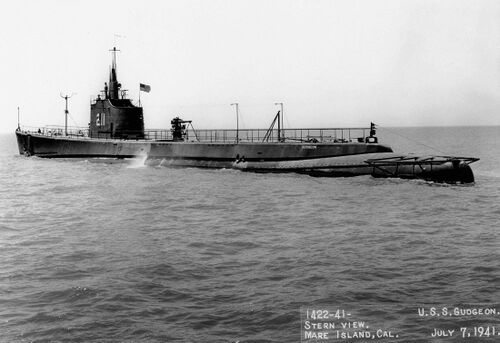
Page created by:
Ric Hedman & David Johnston
1999 - 2023 - PigBoats.COM©
Mountlake Terrace, WA, Norfolk, VA
webmaster at pigboats dot com
